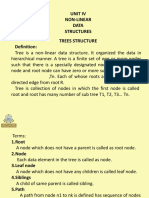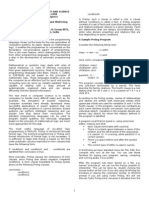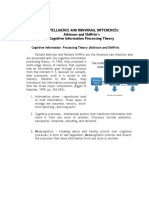0 ratings0% found this document useful (0 votes)
2K viewsLab 2 Tree Traversal in Prolog
Lab 2 Tree Traversal in Prolog
Uploaded by
chakravarthyashokThis document contains a Prolog program for performing operations on binary trees, including inserting and deleting nodes, and traversing trees using pre-order, in-order, post-order, and breadth-first ordering. It provides clauses for these operations and asks the reader to test the clauses, write a clause to combine two trees, and write a clause to find the path from the root to a given element.
Copyright:
Attribution Non-Commercial (BY-NC)
Available Formats
Download as DOC, PDF, TXT or read online from Scribd
Lab 2 Tree Traversal in Prolog
Lab 2 Tree Traversal in Prolog
Uploaded by
chakravarthyashok0 ratings0% found this document useful (0 votes)
2K views2 pagesThis document contains a Prolog program for performing operations on binary trees, including inserting and deleting nodes, and traversing trees using pre-order, in-order, post-order, and breadth-first ordering. It provides clauses for these operations and asks the reader to test the clauses, write a clause to combine two trees, and write a clause to find the path from the root to a given element.
Copyright
© Attribution Non-Commercial (BY-NC)
Available Formats
DOC, PDF, TXT or read online from Scribd
Share this document
Did you find this document useful?
Is this content inappropriate?
This document contains a Prolog program for performing operations on binary trees, including inserting and deleting nodes, and traversing trees using pre-order, in-order, post-order, and breadth-first ordering. It provides clauses for these operations and asks the reader to test the clauses, write a clause to combine two trees, and write a clause to find the path from the root to a given element.
Copyright:
Attribution Non-Commercial (BY-NC)
Available Formats
Download as DOC, PDF, TXT or read online from Scribd
Download as doc, pdf, or txt
0 ratings0% found this document useful (0 votes)
2K views2 pagesLab 2 Tree Traversal in Prolog
Lab 2 Tree Traversal in Prolog
Uploaded by
chakravarthyashokThis document contains a Prolog program for performing operations on binary trees, including inserting and deleting nodes, and traversing trees using pre-order, in-order, post-order, and breadth-first ordering. It provides clauses for these operations and asks the reader to test the clauses, write a clause to combine two trees, and write a clause to find the path from the root to a given element.
Copyright:
Attribution Non-Commercial (BY-NC)
Available Formats
Download as DOC, PDF, TXT or read online from Scribd
Download as doc, pdf, or txt
You are on page 1of 2
BIRLA INSTITUTE OF TECHNOLOGY AND SCIENCE
Second Semester 2007-2008
EA C461 Artificial Intelligence
Lab 1: Tree Traversal in PROLOG
Document Prepared By:
Mukesh Kumar Rohil, CS & IS Group BITS, Pilani – 333031 (Rajasthan),
India rohil@bits-pilani.ac.in
Given below is a program containing some operations which we can
perform on a binary-tree.
Do the following:
1. Test each of the clauses for a sample binary tree.
2. Write a clause to combine two binary trees and get one binary
tree.
3. Write a clause so as to find a path from root to a given element
if the element is a node of the tree.
/* insert_leaf(X, Tree, Tree1) is true if Tree1 is the result of
inserting */
/* the element X as a leaf in the ordered binary tree Tree. If the
*/
/* element X is already in the tree, the tree is unchanged.
*/
insert_leaf(X, void, tree(X,void,void)):-!.
insert_leaf(X, Tree, Tree):-
Tree=tree(X,_,_), !.
insert_leaf(X, tree(Y,L,R), tree(Y,L1,R)):-
X < Y, !,
insert_leaf(X, L, L1).
insert_leaf(X, tree(Y,L,R), tree(Y,L,R1)):-
insert_leaf(X, R, R1).
/* delete_node(X, Tree, Tree1) is true if Tree1 is the result of
deleting */
/* the element X from the ordered binary tree Tree.
*/
delete_node(X, tree(X,L,void), L):-!.
delete_node(X, tree(X,L,R), Tree):-!,
left_rest(R, Y, R1),
Tree=tree(Y,L,R1).
delete_node(X, tree(Y,L,R), tree(Y,L1,R)):-
X < Y, !,
delete_node(X, L, L1).
delete_node(X, tree(Y,L,R), tree(Y,L,R1)):-
delete_node(X, R, R1).
/* left_rest(Tree, Left, Rest) is true if Left is the leftmost element
in */
/* the binary tree Tree, and Rest is the rest of the tree.
*/
left_rest(tree(X,void,R), X, R):-!.
left_rest(tree(X,L,R), Y, tree(X,L1,R)):-left_rest(L, Y, L1).
/* pre_order(Tree, L) is true if L is a pre-order traversal of the
binary */
/* tree Tree.
*/
pre_order(T, L):-pre_order_dl(T, L, []).
pre_order_dl(tree(X,L,R), [X|Xs], Zs):-
pre_order_dl(R, Ys, Zs),
pre_order_dl(L, Xs, Ys).
pre_order_dl(void, Xs, Xs).
/* in_order(Tree, L) is true if L is an in-order traversal of the
binary */
/* tree Tree.
*/
in_order(T, L):-in_order_dl(T, L, []).
in_order_dl(tree(X,L,R), Xs, Zs):-
in_order_dl(R, Ys, Zs),
in_order_dl(L, Xs, [X|Ys]).
in_order_dl(void, Xs, Xs).
/* post_order(Tree, L) is true if L is a post-order traversal of the
*/
/* binary tree Tree.
*/
post_order(T, L):-post_order_dl(T, L, []).
post_order_dl(tree(X,L,R), Xs, Zs):-
post_order_dl(R, Ys, [X|Zs]),
post_order_dl(L, Xs, Ys).
post_order_dl(void, Xs, Xs).
/* breadth_order(BinaryTree, List) is true if List is the level-by-
level */
/* traversal of BinaryTree.
*/
/* This procedure uses a queue implemented as a difference list with a
*/
/* counter. It can be used backwards, that is, it can be used to
*/
/* enumerate, by backtracking, every BinaryTree for which List is the
*/
/* level-by-level traversal. For a list of n elements, the number of
*/
/* binary trees is the n-th Catalan number - see "Data Structures and
*/
/* Program Design in C" by Kruse, Leung and Tondo.
*/
breadth_order(Tree, List):-
breadth_order_1(s(zero), [Tree|Trees], Trees, List).
breadth_order_1(zero, Trees, Trees, []).
breadth_order_1(s(N), [void|Trees0], Trees, List):-
breadth_order_1(N, Trees0, Trees, List).
breadth_order_1(s(N), [tree(X,L,R)|Trees0], [L,R|Trees], [X|List]):-
breadth_order_1(s(s(N)), Trees0, Trees, List).
You might also like
- Deaf and Hard HearingDocument41 pagesDeaf and Hard Hearingged rocamoraNo ratings yet
- Lecture 5Document25 pagesLecture 5satyabashaNo ratings yet
- Data Struture Unit 4Document82 pagesData Struture Unit 4akashNo ratings yet
- Trees (BST)Document17 pagesTrees (BST)logan159No ratings yet
- Disc04 PDFDocument9 pagesDisc04 PDFzhen huNo ratings yet
- Final Dsa ReportDocument13 pagesFinal Dsa ReportsuprotikpanjaNo ratings yet
- CS3353 Unit4Document20 pagesCS3353 Unit4Padmapriya ThianuNo ratings yet
- Arrays LinkedList CheatSheetDocument7 pagesArrays LinkedList CheatSheetYashaswini SNo ratings yet
- TreeSoft Set vs. HyperSoft Set and Fuzzy-Extensions of TreeSoft SetsDocument5 pagesTreeSoft Set vs. HyperSoft Set and Fuzzy-Extensions of TreeSoft SetsVictor HermannNo ratings yet
- Data Structures: Data Object Set or Collection of InstancesDocument26 pagesData Structures: Data Object Set or Collection of InstanceskravireddyNo ratings yet
- Disc05 SolDocument8 pagesDisc05 SollrcrwolrerineNo ratings yet
- Suprotik Panja - DSDocument14 pagesSuprotik Panja - DSsuprotikpanjaNo ratings yet
- Unit 4Document30 pagesUnit 4Vasantha KumariNo ratings yet
- Data Structures and Files Teachers' Laboratory ManualDocument26 pagesData Structures and Files Teachers' Laboratory Manualgagan-randhava-8248No ratings yet
- Prolog Tutorial 1: Questions and AnswersDocument4 pagesProlog Tutorial 1: Questions and AnswersMC. Rene Solis R.100% (3)
- TreeDocument654 pagesTreesumit100% (1)
- Elementary Data Structures: Steven SkienaDocument25 pagesElementary Data Structures: Steven SkienasatyabashaNo ratings yet
- Specication of The Unix File System: A Comparative Case StudyDocument15 pagesSpecication of The Unix File System: A Comparative Case StudyNaresh ChowNo ratings yet
- DataStructures Unit 3Document49 pagesDataStructures Unit 3DIVAKAR .K.GNo ratings yet
- Pds ch-3 PrintDocument24 pagesPds ch-3 Printnanda22051978No ratings yet
- IM 512 3.0 (I) Mathematical Software: Dr. TGI FernandoDocument11 pagesIM 512 3.0 (I) Mathematical Software: Dr. TGI Fernandoamila_vithanageNo ratings yet
- TreeDocument21 pagesTreeMohammed SaimNo ratings yet
- Notes 4Document22 pagesNotes 4februarydtzNo ratings yet
- ds102 ps6 PDFDocument11 pagesds102 ps6 PDFSumathi KannaNo ratings yet
- CDT-22 Interval TreesDocument7 pagesCDT-22 Interval TreesKishore MyNo ratings yet
- Tree Data StructureDocument13 pagesTree Data Structuresaadkhann005No ratings yet
- MUD ReportDocument9 pagesMUD ReportToni IvankovićNo ratings yet
- Inbound 1087863477528516330Document9 pagesInbound 1087863477528516330sudeepimagNo ratings yet
- Ch6 - Binary Search TreesDocument25 pagesCh6 - Binary Search Treesrupinder18No ratings yet
- Binary TreesDocument29 pagesBinary TreesYogesh ShindeNo ratings yet
- Ak Data Structure and Algorithms Unit 1Document6 pagesAk Data Structure and Algorithms Unit 1Shirin RazdanNo ratings yet
- Python Course - VII Lists and TuplesDocument9 pagesPython Course - VII Lists and TuplesSwapnilSauravNo ratings yet
- Tree 3Document56 pagesTree 3VINAY PRAJWALNo ratings yet
- An Object-Oriented Type and Effect System: Aivar Annamaa University of Tartu Aivar - Annamaa@ut - EeDocument20 pagesAn Object-Oriented Type and Effect System: Aivar Annamaa University of Tartu Aivar - Annamaa@ut - EeaivarannamaaNo ratings yet
- UNIT1 Data StructuresDocument15 pagesUNIT1 Data StructuresSumit RajputNo ratings yet
- Mcs 021Document12 pagesMcs 021SANTU DEYNo ratings yet
- Van Emde Boas TreesDocument5 pagesVan Emde Boas TreesseidametovaNo ratings yet
- Mathematical Neuroscience 1st Edition Stanislaw Brzychczy All Chapters Instant DownloadDocument70 pagesMathematical Neuroscience 1st Edition Stanislaw Brzychczy All Chapters Instant Downloadgunnvajolana100% (6)
- CS301 IMP Short NotesDocument53 pagesCS301 IMP Short NotesarslanshaniNo ratings yet
- Definition of TreesDocument7 pagesDefinition of TreesArdhiansyah BaskaraNo ratings yet
- CHAPTER 8 - TREESdsDocument122 pagesCHAPTER 8 - TREESdsvinaydarling063No ratings yet
- Adsa Lab ManualDocument52 pagesAdsa Lab ManualMouli Sai prasadNo ratings yet
- Data Structures - Python 3.7.0Document13 pagesData Structures - Python 3.7.0JustinNo ratings yet
- Segment Trees - Let Us CodeDocument12 pagesSegment Trees - Let Us CodeLê Văn ĐôngNo ratings yet
- Rough Set On Concept LatticeDocument10 pagesRough Set On Concept LatticeAlexander DeckerNo ratings yet
- Binary Search Tree or BSTDocument44 pagesBinary Search Tree or BSTmforytb1No ratings yet
- A Fast Method For Accessing Nodes in The Binary Search TreesDocument8 pagesA Fast Method For Accessing Nodes in The Binary Search TreesirinarmNo ratings yet
- Data Type in PythonDocument15 pagesData Type in PythonVVMNo ratings yet
- Chap 7 TreesDocument55 pagesChap 7 TreesBhavin PanchalNo ratings yet
- Data Structures AND Algorithms: Lecture Notes 10Document104 pagesData Structures AND Algorithms: Lecture Notes 10elemaniaqNo ratings yet
- BST 1 PDFDocument71 pagesBST 1 PDFsudhanNo ratings yet
- Week 7 Search Tree Data StructuresDocument19 pagesWeek 7 Search Tree Data StructuresMPNo ratings yet
- Unit 2Document39 pagesUnit 2Eklavya SudanNo ratings yet
- Rohini - 54944938803 HeapDocument6 pagesRohini - 54944938803 Heappapu varshaNo ratings yet
- Data Structures - Python 3.9.6 DocumentationDocument15 pagesData Structures - Python 3.9.6 DocumentationShahab-ud-din KhanNo ratings yet
- Lab7 Cpcs 204 v3.1 (Trees)Document14 pagesLab7 Cpcs 204 v3.1 (Trees)hina.gillani72No ratings yet
- ProjectdocDocument12 pagesProjectdocMohammad QassasNo ratings yet
- TreesDocument17 pagesTreesravapati navadeepsaiNo ratings yet
- Binary Search Trees: Extc - Dsa - L8 Chhaya NarvekarDocument64 pagesBinary Search Trees: Extc - Dsa - L8 Chhaya NarvekarchhayanarvekarNo ratings yet
- Inference in First-Order LogicDocument43 pagesInference in First-Order LogicchakravarthyashokNo ratings yet
- Learning From Observations: Section 1 - 3Document26 pagesLearning From Observations: Section 1 - 3chakravarthyashokNo ratings yet
- Bayesian Networks: Section 1 - 2Document16 pagesBayesian Networks: Section 1 - 2chakravarthyashokNo ratings yet
- Adversarial Search: Section 1 - 4Document21 pagesAdversarial Search: Section 1 - 4chakravarthyashokNo ratings yet
- M04-Heuristics Informed SearchDocument41 pagesM04-Heuristics Informed SearchchakravarthyashokNo ratings yet
- m07 LogicDocument74 pagesm07 LogicchakravarthyashokNo ratings yet
- Constraint Satisfaction Problems: Section 1 - 3Document34 pagesConstraint Satisfaction Problems: Section 1 - 3chakravarthyashokNo ratings yet
- Lab 6 Lisp Programming and Working With Lisp StudioDocument13 pagesLab 6 Lisp Programming and Working With Lisp Studiochakravarthyashok100% (1)
- AI - Solving Problems by Search 1Document56 pagesAI - Solving Problems by Search 1chakravarthyashokNo ratings yet
- Artificial Intelligence: Introduction: Chapter 1Document12 pagesArtificial Intelligence: Introduction: Chapter 1chakravarthyashokNo ratings yet
- Lab 5 Best First Search For SchedulingDocument3 pagesLab 5 Best First Search For SchedulingchakravarthyashokNo ratings yet
- Lab 3 N - Queens Problem in PrologDocument3 pagesLab 3 N - Queens Problem in PrologchakravarthyashokNo ratings yet
- Artificial Intelligence I: Knowledge Repre-SentationDocument30 pagesArtificial Intelligence I: Knowledge Repre-SentationchakravarthyashokNo ratings yet
- Lab 4 Best First Heuristic SearchDocument8 pagesLab 4 Best First Heuristic SearchchakravarthyashokNo ratings yet
- Lab 1 Introduction To PROLOGDocument4 pagesLab 1 Introduction To PROLOGchakravarthyashokNo ratings yet
- Set de Instrucciones HC12Document32 pagesSet de Instrucciones HC12carlosNo ratings yet
- NCERT Solutions For Class 11 Maths Chapter 7 Permutations and Combinations Exercise 7.3Document8 pagesNCERT Solutions For Class 11 Maths Chapter 7 Permutations and Combinations Exercise 7.35961bhavyapatel79No ratings yet
- Scam KeysDocument21 pagesScam KeysAlbin SarmientoNo ratings yet
- Model Question Paper Biology XII Hindi & English Versions Time - 3 Hours M. M. 75Document22 pagesModel Question Paper Biology XII Hindi & English Versions Time - 3 Hours M. M. 75crazy about readingNo ratings yet
- Prog LA12Document6 pagesProg LA12Angelly V Velasco0% (1)
- English Quarter 2 Week 1: Capsulized Self-Learning Empowerment ToolkitDocument10 pagesEnglish Quarter 2 Week 1: Capsulized Self-Learning Empowerment ToolkitKunyubunani BilatNo ratings yet
- Business Comm Question Bank Sem 1 Watermark1Document19 pagesBusiness Comm Question Bank Sem 1 Watermark1Muzamel AbdellaNo ratings yet
- Lab 5 StorageDocument4 pagesLab 5 StorageAlaa BaraziNo ratings yet
- Q1 W8Document66 pagesQ1 W8Sarah Lomboy EbdaneNo ratings yet
- A2 Progress Test 3Document4 pagesA2 Progress Test 3ngan do67% (3)
- IJCRT2301223Document4 pagesIJCRT2301223praveentoppo2020No ratings yet
- Basico 1 Alp DecemberDocument13 pagesBasico 1 Alp DecemberGuzTavo Alvarock ÃlvarockNo ratings yet
- SW PPT Kuka - Ethernet KRL enDocument10 pagesSW PPT Kuka - Ethernet KRL ensyu.steveNo ratings yet
- Kleinberg Haunting HistoryDocument9 pagesKleinberg Haunting HistorySum Ying LeungNo ratings yet
- Adding SMP Support To A User-Level VMM: DiplomarbeitDocument67 pagesAdding SMP Support To A User-Level VMM: DiplomarbeitMario SchutzNo ratings yet
- Atkinson and Shiffrin's Cognitive Information Processing TheoryDocument3 pagesAtkinson and Shiffrin's Cognitive Information Processing Theorywintermae100% (3)
- Adms-12 FTM-300D Im Eng 2211-BDocument30 pagesAdms-12 FTM-300D Im Eng 2211-BAndréFerreiraNo ratings yet
- Iphone 8Document23 pagesIphone 8Luiz Otávio ChagasNo ratings yet
- Continental Drift: Read & ApplyDocument7 pagesContinental Drift: Read & ApplyCarmencita Rodríguez100% (1)
- English Fluency ExercisesDocument9 pagesEnglish Fluency ExercisesExtraEmailNo ratings yet
- Quiz 002 - Attempt Review PDFDocument3 pagesQuiz 002 - Attempt Review PDFkatherine anne ortizNo ratings yet
- Learn SanskritDocument4 pagesLearn SanskritYasoda NandanNo ratings yet
- Idioms - Phrasal VerbsDocument6 pagesIdioms - Phrasal VerbsCương ChíNo ratings yet
- ZZ Chapter 2Document6 pagesZZ Chapter 2Vanessa Yvonne GurtizaNo ratings yet
- Old Testament Presentation PDFDocument14 pagesOld Testament Presentation PDFThomas KvNo ratings yet
- Rubric For Critical ReviewDocument1 pageRubric For Critical ReviewMaribel Tan-Losloso Nayad100% (1)
- EC A1 Photocopiables ABDocument3 pagesEC A1 Photocopiables ABewabx3No ratings yet
- Presentación. Tema 22 - Classroom ManagementDocument6 pagesPresentación. Tema 22 - Classroom ManagementJanine WilliamsNo ratings yet
- Busuu+Live+Lesson+31+ (I+Have+to+Go+to+My+Exam) + +en+a2+ +student+Document20 pagesBusuu+Live+Lesson+31+ (I+Have+to+Go+to+My+Exam) + +en+a2+ +student+jordi aguirreNo ratings yet








































































































